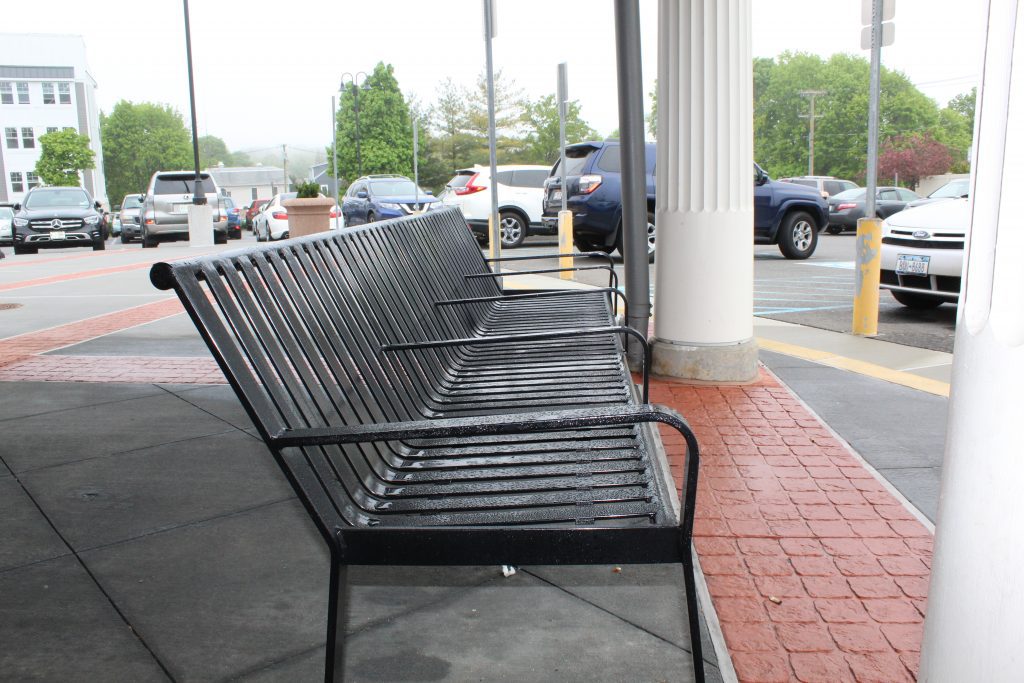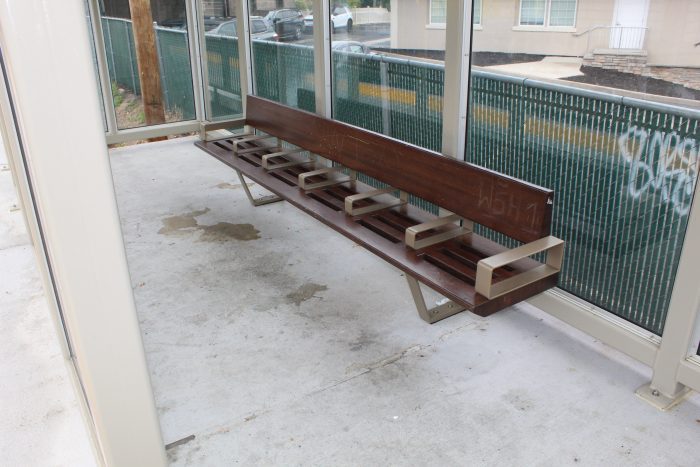Editorial: Transportation tribulation
During his State of the County address, Suffolk County Executive Steve Bellone (D) presented an ambitious vision for a state-of-the-art north terminal at Long Island MacArthur Airport that would connect to both a newly erected convention center and to the main line of the Long Island Rail Road.
“Every great region must have a great regional airport and no one can deny that Long Island is one of the great regions in the nation,” Bellone said.
While Bellone is correct that Long Island is a great region and that it could benefit from a modernized airport terminal at MacArthur, the staff of TBR News Media would like to remind the county executive that there is still so much work to be done before this dream can ever materialize.
In its present form, Long Island’s prehistoric mass transit network is vastly unprepared to support Bellone’s grand vision. Look no further than the Long Island Expressway to discover the backward state of transportation affairs on the Island.
If one is lucky enough to be on the road at an hour when the expressway is not crammed with cars and trucks, there still remains the herculean task of dodging potholes. Out-of-state residents are horrified by the medieval conditions of this roadway — and the carnage inflicted upon their tires and front axles.
The LIRR offers little alternative. While railways around the nation and globe have modernized and expedited their services, Suffolk County residents ride home at a sluggish pace aboard rickety train cars. Riding the LIRR today is uncomfortable, exhausting and, frankly, not worth the price of the ticket.
Our airways do require a modern renovation, but so do our railways and roadways. Policymakers and regional planners need to consider these projects in tandem. Airports and train stations are not standalone facilities but part of a broader, integrated transportation ecosystem. It is that ecosystem that needs an overhaul.
It makes little sense for Suffolk County residents to dodge potholes en route to their state-of-the-art regional airport. It is equally nonsensical to bring 20th-century train cars into a modernized transportation hub.
In Suffolk County, leaders offer us bold visions for change without a roadmap to get us there. Our various public transit systems are remnants of a bygone way of life, artifacts of a time when the county had far fewer residents.
The challenges of immobility are real, likely a result of failed planning some decades ago. Our residents require relief right now as their freedom of movement and quality of life are both dangerously impeded.
TBR News Media sees the benefits of a modernized terminal at MacArthur, and believes Bellone’s idea is a good one. But there is a whole lot of work to be done before we can get there.
TBR News Media Police Blotter for issue of May 26, 2022
The following incidents have been reported by Suffolk County Police:
Commack
■ A man and a woman entered HomeGoods on Henry Street in Commack on May 20 and allegedly stole assorted bedding valued at $320.
■ Bunty’s Jewelry on Commack Road in Commack was burglarized on May 16 and over $3,000 worth of jewelry was stolen. Entry was gained by breaking in the rear door.
■ Target located on Veterans Memorial Highway in Commack reported a shoplifter on May 15. A man allegedly stole five printers valued at $1265.
■ A 2010 Dodge Ram 3500 Mega Cab was stolen from the parking lot of Walmart on Crooked Hill Road in Commack on May 15. The vehicle was valued at $15,000.
■ HomeSense on Henry Street in Commack reported a petit larceny on May 15. Two women allegedly stole nine sets of window curtains valued at $450.
■ ShopRite on Garet Place in Commack reported that two men loaded up three shopping carts with assorted food items and allegedly left the store without paying. The items were valued at $1500.
Dix Hills
■ A 2019 Mercedes Benz valued at $30,000 was stolen from a driveway of a residence on Grey Birch Court in Dix Hills on May 20. The car had been left unlocked with the keys inside.
East Setauket
■ Walmart on Nesconset Highway reported a petit larceny on May 20. Two women allegedly filled a shopping cart with miscellaneous items valued at approximately $500 and walked out of the store without paying.
Fort Salonga
■ A 2020 BMW X7 valued at $90,000 was stolen from the driveway of a residence on Milemore Drive on May 17. The key fob had been left inside the vehicle.
Huntington Station
■ Staples on West Jericho Turnpike in Huntington Station called the police on May 20 to report that a man and a woman allegedly stole an Epson EcoTank printer worth $550 and a HP Smart Tank printer worth $460.
■ Louis Vuitton on Walt Whitman Road in Huntington Station reported a shoplifter on May 20. A woman allegedly stole a handbag valued at $2370.
Kings Park
■ Flynn-Aire Heating and Air Conditioning on Indian Head Road in Kings Park called the police to report that four work vehicles were broken into on May 17. The rear windows were smashed to gain entry and tools valued at $20,000 were stolen.
Lake Grove
■ Dick’s Sporting Goods at the Smith Haven Mall in Lake Grove reported that two women and a man allegedly stole assorted Nike clothing valued at $880.
■ A woman shopping at Trader Joe’s on Nesconset Highway in Lake Grove on May 19 reported that an unknown person stole her purse containing credit cards and cash from her shopping cart.
■ DSW Designer Shoe Warehouse on Middle Country Road in Lake Grove called the police on May to 18 to report that a man and a woman allegedly stole miscellaneous sneakers and footwear valued at approximately $250.
■ Macy’s at the Smith Haven Mall in Lake Grove reported a petit larceny on May 17. Two women and a man allegedly stole 15 miscellaneous clothing items valued at $985.
Mount Sinai
■ A resident on Apricot Lane in Mount Sinai reported that someone entered their unlocked vehicle on May 17 and stole sunglasses and various items valued at $250.
■ A woman visiting Heritage Park on Mount Sinai-Coram Road in Mount Sinai on May 18 reported that her purse containing credit cards and cash was stolen from her car. Someone attempted to use the credit cards at a local Walmart a short time later.
Port Jefferson Station
■ Family Dollar on Route 112 in Port Jefferson Station reported a petit larceny on May 21. Three men and a woman allegedly stole assorted items valued at $50.
■ A resident on Kelsey Avenue in Port Jefferson Station reported that someone cut a lock on their backyard shed and stole power tools valued at approximately $600 on May 21.
■ Verizon Wireless on Nesconset Highway in Port Jefferson Station reported that a man allegedly stole an iPhone 13 Pro valued at approximately $1000 by cutting the security cable on May 19.
■ A resident on Homestead Avenue in Port Jefferson Station called the police to report that someone entered their unlocked vehicle on May 19 and stole property worth $120.
■ T.J. Maxx on Nesconset Highway in Port Jefferson Station reported a petit larceny on May 20. A man and a woman allegedly stole assorted bedding and men’s clothing valued at $400.
Rocky Point
■ Kohl’s on Route 25A in Rocky Point reported a shoplifter on May 14. A woman allegedly stole assorted clothing valued at approximately $430.
Selden
■ A resident on Elmwood Avenue in Selden called the police on May 21 to report that someone stole a Ring Home Security Camera from his front porch.
■ A lawnmower and tools valued at approximately $200 were stolen from the backyard of a residence on Mooney Pond Road in Selden on May 16.
South Setauket
■ Target on Pond Path in South Setauket reported a shoplifter on May 19. A man allegedly stole a Keurig coffee maker valued at $110 and eight assorted toys valued at $210.
■ Stop & Shop on Pond Path in South Setauket called the police on May 18 to report a shoplifter. A man allegedly placed 30 miscellaneous food items in his shopping cart and walked out of the store without paying. The merchandise was valued at $325.
■ A man allegedly stole copper wire worth $765 from Home Depot on Pond Path in South Setauket on May 16.
Suffolk County Crime Stoppers offers a cash reward for information that leads to an arrest. Anyone with information about these incidents can contact Suffolk County Crime Stoppers to submit an anonymous tip by calling 1-800-220-TIPS.
— COMPILED BY HEIDI SUTTON
Hostile architecture: The blurring line between public and private space

By Raymond Janis
During our investigation of seating shortages at Port Jefferson train station, TBR News Media took a closer look at the emerging field of hostile architecture, a design movement that employs subtle and often harmful means to alter public spaces.
Robert Rosenberger, associate professor in the School of Public Policy at the Georgia Institute of Technology, is an expert on the subject of hostile design. He said through architecture, urban designers today can manipulate the environment to ward off certain populations.
“Hostile architecture refers to when objects in public spaces are designed in a way to control those spaces and push out or control the behavior of already vulnerable groups,” he said in a phone interview. “Benches redesigned to deter people from sleeping on them is one of the main examples of hostile architecture, and we mainly see that done through the addition of armrests.”
The issue of hostile architecture was first observed on social media, according to Rosenberger. However, the issue gained traction among journalists and academics is now being explored as its own discipline.
Professor Setha Low is director of The Public Space Research Group at The Graduate Center, City University of New York. She researches hostile design and works with design students to envision public spaces that can be more user-friendly and inclusive.
Hostile architecture is not only disruptive for the individuals that it targets. Low suggests that other vulnerable demographics can also get caught within the crosshairs.
“It doesn’t just make it hostile or unwelcoming for individuals who might want to sleep there,” she said. “It also doesn’t allow older people who might want a place to sit.”
Not all public spaces are equally public and accessible. In cases where hostile design is practiced, public environments can be highly restrictive and unwelcoming, and effectively private.
“Public space is only as public as you make it,” Low said, adding. “There are a lot of ways we privatize environments and many things that can be done to reduce the publicness of the public space.”
Hostilely designed structures can be difficult to identify as they often blend into the built environment. Because they affect only certain populations, those unaffected can be oblivious to the problem.
“People who are not targeted by these designs sometimes don’t even recognize that they are there,” Rosenberger said. “Something that’s interesting about hostile architecture is that once you see it for the first time, you start seeing it everywhere.”
While there are laws regulating public spaces to ensure handicap accessibility, such as the Americans with Disabilities Act, there are currently no laws that prohibit hostile architecture. “I don’t see anything at the national or state level where there is some kind of prohibition on this kind of design,” Rosenberger said.‘Our technologies are going to have values built into them. We have to actively decide the values that we want because otherwise, we have these other values creeping in that we may not even notice.’ — Robert Rosenberger
While hostile design most noticeably includes adding materials, such as armrests along public benches, it can also take form through subtraction.
“One of the trends in hostile architecture is removing objects from spaces rather than adding things to those objects,” Rosenberger said. “It’s a kind of design through removal, an architecture that involves no architecture.” He added, “Even if you are in a space and there are no objects there, that can be a form of hostile design as well.”
For Low, hostile architecture is not a design issue. Rather, it is a human issue which speaks to the ways in which people interact with one another. Architecture, therefore, is merely the reflection of the values of a society.
“I don’t think it’s the architecture going wrong,” she said. “I think we’re in a moment in time when some of the more negative impulses and illiberal activities are being tolerated when they wouldn’t have been in other times.” She added, “How we build our environment — our villages, our benches and everything else — is directly related to how we view ourselves and our society at that moment.”
Rosenberger sees two principal values embodied by the hostile architecture movement. “The first one would be a kind of technocratic control, a value of controlling spaces and who is in those spaces,” he said. “The other is a value of washing our hands of that and saying, ‘There’s nothing to see here — the space is innocent.’” He added, “The spaces and the objects are not innocent. They may look innocent, but actually we have values built into that space.”
Low believes public space is always designed with the intent to evoke a certain feeling or experience from the user. For this reason, a public space cannot be innocent or neutral. “The built environment is never neutral,” she said. “How do you feel in different places? Why do you feel that way and what is it in the built environment that is making you feel either encouraged to come or not?”
Rosenberger suggested that to overcome hostile design, a community must first define its own values and then rebuild the environment to express them.
“Our technologies are going to have values built into them,” he said. “We have to actively decide the values that we want because otherwise, we have these other values creeping in that we may not even notice.”
One-on-one with Gerard Gang
Port Jeff village trustee candidate’s creative approach to decision-making
By Raymond Janis
This week, TBR News Media sat down with Gerard Gang, candidate in the upcoming Village of Port Jefferson trustee elections June 21. In our interview, Gang discussed his professional background in packaging, his plans to improve senior services, cultural programs in the village, and more.
What is your background and why would you like to be involved in local government?
First, I want to say that I am honored to be introduced to the public. For those who don’t know me, I live in Port Jefferson and have been here for 32 years. My wife, Patty, and I have raised two children in the school district. She was a teacher’s assistant in the elementary school and is the hearts of many children no matter where we go.
Professionally, I come from a background in fragrance and cosmetic packaging as a design director. I was responsible for both the marketing and the creative services. Combined with my other creative professional skills, this will be excellent experience and an asset to the role of trustee.
I want to be a representative of the residents. I’m retired and have the time to be involved in our wonderful village and to create ways of communicating better between the residents and the village. I was a member of the economic development council that founded the farmers market, and I was also a member of the [village] Beautification Committee. I am presently on the Six Acre Park Committee, helping to conceptualize the arboretum and walking park in Upper Port. As residents come to know me, they will learn that I am always willing to listen and make the necessary changes within myself for those whom I may represent.
I also believe that we need to preserve our history, to strengthen our relationships and opportunities, and to optimize our facilities and programs. We need to create new experiences, foster new ideas and increase our revenue to prevent further financial hardship on the taxpayer, who is already struggling with inflation and other economic restraints caused by the pandemic.
A trustee must wear many hats and accept the challenges that no doubt will arise. I am ready, willing and excited to do just that.
Can you describe your experience working with the Six Acre Park Committee?
I have been on the committee since April. Some of my background is in landscaping. As a child, I worked on a farm for years and all the way through college. My interest was to develop a beautiful arboretum. There’s such a need in Upper Port to establish something beautiful, something to enjoy.
We have the condos up there and the new apartments being established. Those people need to have a place where they can walk, meditate and just relax. I think it’s so important for the hospital workers up there. On a stressful day, it would be nice to take 10 minutes to take a stroll through something that’s beautiful, something that’s natural.
How is your professional experience applicable to the work of a trustee?
My experience in packaging — as well as in landscape design, floral design and interior design — has taught me how to focus.
In package design, especially in the studio where I worked, we worked directly with the printer, so we were actually on board when a color was mixed. My eye is extremely sensitive. People will say, “That’s black,” when it’s actually a blue-black, or it has a little bit of a red cast to it. My keen eye will help to take this beautiful village and move it into the future.

It is important to me to hold onto the village’s historic character. I believe in the restoration of Upper Port and I hope to be working with the Architectural Review Committee to update design guidelines to preserve the village’s charm, the integrity of the materials used and the colors selected.
In your opinion, what are the most critical issues facing the village?
The erosion of the bluff and the bond issue is a pretty big topic. I believe in the initial Phase I to establish the lower wall so that we can still have access to the beach. Until all of the information is presented about the upper wall — the drainage and whether to save the club — I will await making any decision until all facts are gathered and until we know what funding is available.
The other issue facing the village is the decline in student enrollment within our school district. The well-being of our children is very important to me. As a trustee, I will work to make sure that an ample population of students is maintained so that the diverse assortment of programs and activities are available to them. I will foster ideas on the possibility of rezoning the school district to include all of Port Jefferson. In rezoning, we would increase the diversity of our students and, in turn, our state aid while hopefully keeping our school taxes balanced. For many, rezoning would lower their school taxes while enriching our programs and also provide a full-day pre-K program.
Another critical issue is increasing village revenue to offset our increases in taxes. I have the knowledge to build upon the revenue in our village by staying within our budget allowances. Through new programs at the Village Center, the country club, the beach and within our village, we have the ability to generate profits that can stabilize our taxes while also providing quality programs for all ages.
I do support the restoration of Upper Port. It needs to happen and it would be a benefit for all of us as that’s the gateway into our village. I would work with the Architectural Review Committee and with the planning committee to do that.
What are your thoughts on the availability of cultural programs in the village and is there room for expansion?
There is definitely room for expansion. We have a lot of cultural aspects in the village and one of my platforms is to optimize the Village Center to create more programs and revenue. Through the years, I have been a floral designer, a coordinator of fundraisers, a curator of art exhibits and local art groups. I have the knowledge and the ability to organize events and build upon the revenue of the venue.

One of my ideas is to develop new programs at the Village Center. One of them would be to create an opportunity for the disabled and the autistic children to express themselves and communicate through art. My wife worked in the school as a teaching assistant and I know that many of these children express themselves and communicate better through art. I would like to encourage the public to host special events through dinners and senior programs there.
I would also like to create a council for the aging committee. Through educational programs, special events and weekly gatherings, we as a community can address and assist our seniors in their needs. There are so many older people in our village that have been the founders of the village, that have been the strength of the village. It would be wonderful for them to be able to live out their full lives in the village.
What are some ways in which the Village Center can be upgraded?
The Village Center is a wonderful building. There are so many opportunities there and it’s wonderful to see that two of the class reunions for the high school are now going to be in the Village Center. It’s great to see that it’s beginning to be used for different reasons. All it takes is one person to come in and say, “Wow, this can be a great environment.”
I have actually done a wedding there. Once you are on the second and third floors, it’s a wonderful environment. It’s beautiful and the view out the window is incredible. With the proper resources and event planners, with flowers and catering, it can be an even more beautiful venue.
I would like to encourage brides to come in and take a look at the place. If you are having a special event, a party or a family reunion, the opportunity is there. I would like to make some small changes downstairs so that as you walk in, it has that appeal that would make you want to host a special occasion there.

How can residents play a more active role in decision-making?
As I went door to door, I spoke to so many people about their concerns. I listened to their stories and everything else. What I want to express to so many of the people is that I ask the residents to reach out, to become more active, to communicate and to show up to our village meetings.
The trustees are here to listen to you, so communicate with them. Voice your opinions because your concerns are my concerns and they should be the trustees’ concerns. As I like to say, one positive thought creates one positive word and results in a positive action. As much as you can communicate, it just opens up doors for things to change.
Is there anything else that you would like to say to our readers?There are so many positive things to look at, to enjoy and to talk about. We should build upon the positives of the village, not just upon the negatives. — Gerard Gang
I actually hope to continue to meet more people. I so enjoy campaigning, meeting so many new people, talking to young people, older people. It was wonderful to come upon the seniors of our village and to listen to their stories. It was just so nice to interact with them because they need to talk and they want to socialize.
There are so many positive things to look at, to enjoy and to talk about. We should build upon the positives of the village, not just upon the negatives. Like I said before, you take a positive word and it becomes an idea and then it turns into a positive action.
I hope to become a trustee. It’s in my blood now — the passion that I have to help people and to help the village.
Part I: Mental health strain for Long Islanders
The first in a two-part series, this article highlights the ways COVID-19 exacerbated an already difficult mental health landscape on Long Island, particularly for adolescents. Amid isolation and uncertainty, residents had an increase in anxiety-related and mental health crises. Additionally, residents in acute distress who arrived at the emergency room sometimes had to wait hours or days for an inpatient psychiatric bed. In the second feature, which will appear in a future edition, mental health workers describe the challenges of their work during the pandemic.
COVID-19 has taken its toll on mental health throughout Suffolk County, as people in a range of ages confront challenges related to isolation, depression, anxiety and grief.
Area hospitals report that inpatient psychiatric beds are rarely empty. Indeed, patients have had to receive treatment in the emergency room at times for a day or more as they wait for an available inpatient psychiatric bed.
“Our emergency room has two behavioral health beds, but often, we have more patients waiting for admission to [the] inpatient psychiatry unit,” said Dr. Adnan Sarcevic, chairman of the Psychiatry Department at Huntington Hospital.
While patients receive the same treatment in the emergency room that they would in an inpatient unit, some types of intervention, like group psychotherapy “cannot be provided in an emergency room setting,” Sarcevic said.
COVID also exacerbated the shortage of beds when some units had to close after an outbreak of the virus.
“We had periods when some psychiatric inpatient units were closed for a variety of different reasons including COVID outbreaks” which created a shortage of beds, Sarcevic added.
At St. Catherine of Siena in Smithtown, beds filled up as soon as one opened, said Dr. Michel Khlat, chief medical officer.
Adolescent strains
The pandemic exacerbated trends that already reflected the mental health strain among youth and adolescents.
For the previous decade, youth presentations for mental health crises in the emergency room had been increasing.
During the pandemic, those numbers climbed nationally and on Long Island. Estimates of anxiety among youth increased to 20%, which is dramatically higher than the 12% prior to the pandemic, said Dr. Vera Feuer, associate vice president in the School Mental Health program at Northwell Health. Depression has also reached about 20%, which was previously below 10%.
Additionally, the pandemic caused a three-fold increase in children with eating disorders, which is consistent with new Centers for Disease Control and Prevention data, Feuer added.
“There’s a real big increase in presentation to the emergency room” with youth who are considering suicide, particularly for girls who are 10 to 13 years old.
Additionally, adolescents are showing an increase in tic disorders, which are involuntary movements of the neck, eye or facial movements, Feuer said. While some studies suggest a link between depression and these movements, other research has linked them to the increasing use of social media.
As for the availability of mental health services, adolescents are continuing to find it difficult to become outpatients for an overburdened mental health care system, which increases the need for emergency services.
Community services are often “saturated,” Feuer said. “There are not enough child psychiatrists” which means that children go without care for longer, she said.
On Long Island, the wait for inpatient beds is not as long as it reportedly has been in other areas of the country.
“We do have kids waiting at least a day or over the weekend,” said Feuer. She suggested that access to beds and to crisis programs in school have mitigated some of the adolescent demand.
Dr. Stacy Eagle, director of Psychiatry at St. Charles Hospital, cautioned that the potential for addiction and substance abuse is “concerning. Even marijuana is dangerous, because you don’t know what it’s laced with and it can become incredibly addicting.”
Broader challenges
The shortage of inpatient beds predated the arrival of COVID, with mask mandates, social distancing, remote learning and at-home work altering routines and creating stressors that often increased anxiety and triggered the kind of self-medication that led to substance abuse.
“I’ve seen it step up on a daily, weekly, monthly basis” in terms of generalized anxiety disorders and panic attacks, said Dr. Jeffrey Wheeler, director of the Emergency Department at St. Charles Hospital in Port Jefferson.
Eagle said she has seen more anxiety, mood disorders and substance abuse, with more acute patients coming in from schools.
Doctors suggested that COVID itself can contribute to the worsening of a person’s emotional well-being.
“COVID certainly plays a role in mental health, both as a psychosocial stressor and due to the neurotropic nature” of the virus, said Sarcevic.
The types of treatment varies according to the severity of the symptoms, the underlying conditions, and any ongoing treatment plans.
“Some people come in who are in need of medication to be stabilized for depression,” said Khlat.
To accommodate the increasing need for non-acute psychiatric services, health care professionals have been offering telepsychiatry help.
In the last three months, St. Catherine of Siena expanded their telepsychiatry services, which had been offered primarily on the weekends, to seven days a week.
“Due to the influx of patients we’re having, with COVID depression we had to [expand that] to the rest of the week,” Khlat said. These services “helped us out a lot.”
Silver lining
Feuer suggested a few silver linings amidst the health care crisis.
“The attention to something we know has been a problem for a long time” will help the community, she said. “I’m hoping the right resources and interventions will come.”
Additionally, the increased vigilance of mental health challenges has enabled people to feel that asking for mental health resources is something they can, and should, do.
“It has normalized these conversations,” Dr. Feuer said.
Available resources
Dr. Gregson Pigott, commissioner of the Suffolk County Department of Health Services, urged people who think they need help to get it right away.
Those people seeking help for substance abuse or mental health can visit www.SuffolkStopAddiction.org to find a network of providers in the 2022 Suffolk County Directory of Behavioral Health Services guide.
The following are resources available to those in crisis:
— Family Services League’s Diagnostic, Assessment and Stability Hub (DASH) program. This is a 24-hour stabilization response program for children and adults in crisis due to substance abuse, mental illness and other life stressors. They are located at 90 Adams Avenue in Hauppauge. Their phone number is 631-952-3333.
— A free 24-hour hotline: 631-751-7500, or www.responsehotline.org.
— A Comprehensive Psychiatric Emergency Program (CPEP) at Stony Brook Hospital at 101 Nicolls Rd in Stony Brook is available at 631-444-6050. CPEP has voluntary and involuntary emergency psychiatric services for children and adults every day.
“It is important for individuals to engage in self-care,” Pigott wrote in an email. “Listening to each other and recognizing the signs of mental illness and substance use can help mitigate a developing crisis.”
United Nations International Yoga Day heads to Port Jefferson Station
Save the date! The Meadow Club, 1147 Route 112, Port Jefferson Station will be hosting the 7th Annual United Nations Day of Yoga on June 21 from 10 a.m. to 3 p.m. The event is open to all and will include a variety of yoga classes for all ages and levels, meditation sessions, vendors and more.
This event is being sponsored by Indu Kaur, Director of The Meadow Club; Jas Singh, founder of ReflectandRespond; Sharmila Nigam, founder of One Love Generation; and Marcy Guzman of The Healing Center at Port Jeff Salt Cave, along with 14 holistic teachers and volunteers.
Brookhaven Councilmember Jonathan Kornreich, Suffolk County Legislator Kara Hahn, Director of the Staller Center Alan Inkles, and President of the Port Jefferson Station/Terryville Chamber of Commerce Jennifer Dzvonar, to name a few, will be in attendance for the candle lighting ceremony to start the morning program.
A vision of Indu Kaur, owner of The Meadow Club, the event is intended to promote harmony, world peace, health and wellness through the various practices of yoga and holistic modalities.
Event speakers include Dr. N who is Board certified Doctor of Integrative Medicine, Alternative Medicine and Doctor of Humanitarian services with PhD graduated from International Quantum University of Integrative Medicine; and Meditation teacher Bhante Kottave Nanda from Long Island Meditation Center.
Attendees will be able to learn and practice various forms of yoga such as Hatha, Chair, Kundalini, Restorative, Vinyasa, Yin, Yoga Nidra and more from local instructors of Yoga, Pranayama breathing, Ayurveda, Holistic health lifestyle, meditation, Reiki, financial wellbeing and more.
In addition, a delicious vegan vegetarian buffet will be available for a nominal fee along with raffle of baskets valued at $200+ to support this fully volunteered sponsored event and raise awareness of peace with yoga, love, and light. Bring your own yoga mats or mats will be available for purchase.
The event is FREE and open to the public. RSVP requested by calling 631-828-4818.
An evaluation of seating availability at Port Jefferson train station
By Carolyn Sackstein
Since the renovation of Port Jefferson train station in 2019, some previously available seating has been either relocated or removed.
One village resident, who agreed to be interviewed for this story but asked to be unnamed, suggested that a lack of available seating at the station poses an unnecessary burden for the elderly and physically disabled.
“There is no reason we shouldn’t have access to seating, enough of it available to all,” the resident said. “We have to treat all people with dignity. People who are handicapped, those who are paying, the railroad owes us a seat as well as comfort.”
While the indoor ticket area has seating for 12, these seats are available only from 6 a.m. to 6 p.m. During the time when the area is closed to the public, outdoor seating becomes limited.
With few options to sit along the platform, some passengers have resorted to sitting on the floor or on the steps of the platform.

Photo by Carolyn Sackstein
Gregory Adams, a resident of Wyandanch, uses a cane to walk. He said the present layout of the train station impedes his ability to sit comfortably while waiting for a train.
“A person like me waiting for the train needs to sit down,” he said. “Not having a place to sit has been a hardship. I have to sit on the steps over there, waiting.”
Historical context
The Port Jefferson station has undergone a series of transformations over the last few decades.
A 2001 restoration of the station returned the facility to its 1903 design by architects John J. Petit and James C. Green. In 2019 Long Island Rail Road completed its most recent updates with a refurbished and painted ticketing area, updated restrooms, new paving, curbing and signage, electronic charging stations, parking stall painting, traffic flow markings and brick paver walkways. The restoration was much needed, according to some village residents who are pleased overall with the improvements made to the layout.
Until recently, there was only one designated outdoor seating area at the station, located on the far end of the platform. This enclosure includes a bench with armrests that designate six seats. It is located between the pedestrian bridge, which links the south parking lot to the platform north of the tracks, and the ticketing area.
Village resident Mary Dylan was sitting on the new bench when TBR News Media asked her for a comment. Dylan considered her experience of using the new seating area to be a positive one. “It is nice to see all the new improvements [at the station] and I particularly like the new bench put there,” she said.
TBR News Media approached several other people at the station for comment on the subject of seating. While most were also unwilling to provide their names, some offered commentary of their own experiences with the facility and its amenities.
The indoor ticketing area is manned by at least one LIRR employee during business hours. Those questioned said the presence of LIRR personnel on-site provided a sense of comfort and security for those sitting indoors.
Other riders said they prefer to wait outside in the fresh air. One person preferred to wait outside as the indoor area is away from public view.
Adams and some other concerned passengers were pleased to learn that the new bench was recently installed outside the ticketing area. The installation of this seating area, which lies on the east side of the ticket office, is an indicator that LIRR is responding to public concerns.
Correction: In an earlier version of this article, famed architect Stanford White was falsely credited for the 1903 design of Port Jefferson train station. The true architects of the station were John J. Petit and James C. Green.
D. None of the Above: The college kids are back and we, and the dog, are exhausted
By Daniel Dunaief

Empty nest? Seriously? I almost want to laugh maniacally when people ask about our empty nest.
For starters, we have a dog and two cats, which means that our nest, such as it is, has plenty of creatures with ongoing needs. One of our neighbors even asks regularly about our “little one.” It still takes me a second to realize she’s not inquiring about our children, who are anything but little, but our dog, who is also over 80 pounds.
The pandemic and the weather have disrupted so much over the last few years that we half expect to see one or both of our children at the airport or on our doorstep at any given moment.
Sure, we’ve had a few weeks where we’ve been on our own (with our pets), but in between, we’ve entertained visitors thrilled to travel again. We, ourselves, have also traveled back and forth to visit family, which means that the whole us-time has morphed into a collection of pet feedings and short trips.
Like so many other parents of college kids, we welcomed our children back to our home recently. It’s a wonderful chance to see them face to face, when they pick their heads up from their phones, and to connect the dots on snippets of their lives that they’ve shared from a distance.
The dog, who loves both of our children something fierce and whose tail threatens to detach from his hindquarters and float to the ceiling each time they return, is completely exhausted. After a few late nights with the kids and their friends, the dog reaches the sidewalk in front of the house, stands stock still, and stares at me, as if to say, “you want me to walk now? Do you have any idea how late I stayed up?”
Once I coax him, in between clenched teeth, away from the house, he still stops at random places, eager to turn around and lay down.
The dog loves it when I chat with a neighbor, which gives him a chance to plop down on the grass and pant, as if I’ve taken him much further than the 1/8th of a mile from our home.
During a recent such pause, a neighbor shared the joy/frustration of having his two children in his house. His wife wants to institute strict rules about comings, goings, and living-under-their-roof. His son, a junior at a nearby college, is delighted for the home-cooked meals, but not so much for the home-cooked rules.
Both of our children have become nocturnal. They have no need to hear birds chirping in the morning, to plow through a plate of pancakes, or to share in the start of another day.
In the “late” evening (which is getting earlier for me each day), our children often appear as we’re going to sleep. Excited to see them, we sit up and engage in what can be competing conversations. It’s like that old joke about a lawyer who moves into town and has almost no business, until another lawyer comes and they’re both working nonstop.
Something about hearing a sibling talk greases the wheels for the other one, who then remembers important details to share.
The next morning, when we’re at our desks, our children are happily sleeping, resting and recovering and our dog is flat out on the floor.
Then again, the fatigue is more than offset by the joy of hearing about their adventures, marveling at their maturation, and steadying ourselves for the moments when they head back to their busy lives.
Comsewogue defense delivers victory over West Islip
By Bill Landon
Comsewogue, the No. 2 seed, had its hands full in the final minute of the Class B boy’s lacrosse semifinal against its third-seeded visitor, West Islip.
Warrior goalkeeper Adam Wachholder had two clutch saves against a surging Lion attack, holding on to the lead for a 6-5 victory on May 24.
Midfielder Justin Bonacci had two goals and two assists; senior attack Michael Katz had an assist and two goals; and teammates Thomas Kennedy and Dylan Rocchio both scored. Wachholder, a sophomore, had 11 saves in net on the day.
The win sends Comsewogue to the Suffolk championship final, where this battle-hardened unit will face off against Smithtown West on Wednesday, June 1 at East Islip High School.
Gametime is set for 4:30 p.m.
— Photos by Bill Landon






































